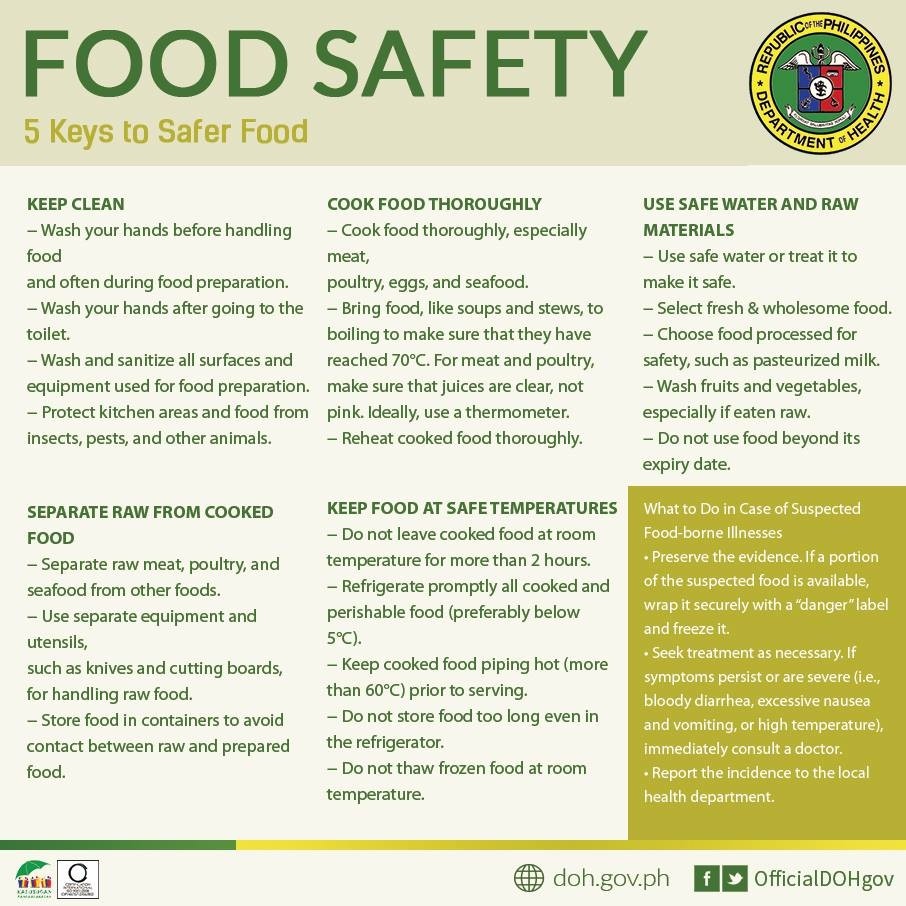Food Safety Tips (DOH)

Five Keys to Safer Food (WHO, 2011)
1. Keep clean.
− Wash your hands before handling food and often during food preparation.
− Wash your hands after going to the toilet.
− Wash & sanitize all surfaces and equipment used for food preparation.
− Protect kitchen areas and food from insects, pests, and other animals.
2. Separate raw from cooked food.
− Separate raw meat, poultry, and seafood from other foods.
− Use separate equipment and utensils, such as knives and cutting boards, for handling raw food.
− Store food in containers to avoid contact between raw and prepared food.
3. Cook food thoroughly.
− Cook food thoroughly, especially meat, poultry, eggs, and seafood.
− Bring food, like soups and stews, to boiling to make sure that they have reached 70°C. For meat and poultry, make sure that juices are clear, not pink. Ideally, use a thermometer.
− Reheat cooked food thoroughly.
4. Keep food at safe temperatures.
− Do not leave cooked food at room temperature for more than 2 hours.
− Refrigerate promptly all cooked and perishable food (preferably below 5°C).
− Keep cooked food piping hot (more than 60°C) prior to serving.
− Do not store food too long even in the refrigerator.
− Do not thaw frozen food at room temperature.
5. Use safe water and raw materials.
− Use safe water or treat it to make it safe.
− Select fresh and wholesome food.
− Choose food processed for safety, such as pasteurized milk.
− Wash fruits and vegetables, especially if eaten raw.
− Do not use food beyond its expiry date.
What to Do in Case of Suspected Food-borne Illnesses:
• Preserve the evidence. If a portion of the suspected food is available, wrap it securely with a “danger” label and freeze it.
• Seek treatment as necessary. If symptoms persist or are severe (i.e., bloody diarrhea, excessive nausea and vomiting, or high temperature), immediately consult a doctor.
• Report the incidence to the local health department. Food and Water-borne Diseases:
• These constitute a group of illnesses caused by any infectious (bacteria, viruses, and parasites) & non-infectious agents (chemical, animal & plant toxins) Common Causes of Food and Water-borne Diseases
• Unsafe sources of drinking water
• Improper disposal of human waste
• Unhygienic practices, like spitting anywhere, blowing or picking the nose
• Unsafe food handling and preparation practices (i.e., street-vended food)
1. Keep clean.
− Wash your hands before handling food and often during food preparation.
− Wash your hands after going to the toilet.
− Wash & sanitize all surfaces and equipment used for food preparation.
− Protect kitchen areas and food from insects, pests, and other animals.
2. Separate raw from cooked food.
− Separate raw meat, poultry, and seafood from other foods.
− Use separate equipment and utensils, such as knives and cutting boards, for handling raw food.
− Store food in containers to avoid contact between raw and prepared food.
3. Cook food thoroughly.
− Cook food thoroughly, especially meat, poultry, eggs, and seafood.
− Bring food, like soups and stews, to boiling to make sure that they have reached 70°C. For meat and poultry, make sure that juices are clear, not pink. Ideally, use a thermometer.
− Reheat cooked food thoroughly.
4. Keep food at safe temperatures.
− Do not leave cooked food at room temperature for more than 2 hours.
− Refrigerate promptly all cooked and perishable food (preferably below 5°C).
− Keep cooked food piping hot (more than 60°C) prior to serving.
− Do not store food too long even in the refrigerator.
− Do not thaw frozen food at room temperature.
5. Use safe water and raw materials.
− Use safe water or treat it to make it safe.
− Select fresh and wholesome food.
− Choose food processed for safety, such as pasteurized milk.
− Wash fruits and vegetables, especially if eaten raw.
− Do not use food beyond its expiry date.
What to Do in Case of Suspected Food-borne Illnesses:
• Preserve the evidence. If a portion of the suspected food is available, wrap it securely with a “danger” label and freeze it.
• Seek treatment as necessary. If symptoms persist or are severe (i.e., bloody diarrhea, excessive nausea and vomiting, or high temperature), immediately consult a doctor.
• Report the incidence to the local health department. Food and Water-borne Diseases:
• These constitute a group of illnesses caused by any infectious (bacteria, viruses, and parasites) & non-infectious agents (chemical, animal & plant toxins) Common Causes of Food and Water-borne Diseases
• Unsafe sources of drinking water
• Improper disposal of human waste
• Unhygienic practices, like spitting anywhere, blowing or picking the nose
• Unsafe food handling and preparation practices (i.e., street-vended food)
- cebfc38d4bc9ee7272f3633da83e51de82.jpg